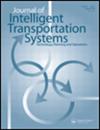高速公路交织路段的合作式纵向变道分布提示
IF 2.8
3区 工程技术
Q3 TRANSPORTATION
Journal of Intelligent Transportation Systems
Pub Date : 2025-03-04
DOI:10.1080/15472450.2023.2301705
引用次数: 0
摘要
高速公路交织路段的变道(LC)集中问题会带来碰撞风险并降低高速公路效率。为解决这一问题,本文提出了一种合作式纵向变道(LC)控制方法。本文章由计算机程序翻译,如有差异,请以英文原文为准。
A cooperative longitudinal lane-changing distributions advisory for a freeway weaving segment
The lane-changing (LC) concentration problem in freeway weaving segments poses crash risks and reduces freeway efficiency. To address this issue, this paper proposes a cooperative longitudinal LC distribution (CLLCD) advisory for freeway weaving segments utilizing cooperative intelligent transport system technology. The weaving segment is divided into sections, and the CLLCD strategy distributes lane changes for each section using a general rule that allows easy calculation of each section’s CLLCD from the maximum permitted number of lane changes for different movements. A corresponding percentage of drivers in each section are then permitted to change lanes from the start of that section. The CLLCD strategy is evaluated for 27 scenarios with varying traffic demands. A sensitivity analysis is conducted to determine optimal parameters, and the performance of the proposed strategy is compared to other methods. This study also explores the working mechanism of the proposed approach using headway data and speed profiles. The effects of the section configurations and penetration rates of connected vehicles (CVs) are discussed. Simulation results show that this easy-to-apply strategy improves speed and delay as effectively as the heuristic algorithms-based strategy. The number of sections does not influence the CLLCD strategy’s performance when the maximum freeway-to-ramp lane changes per section and other parameters per 100 m remain constant. The delay in the weaving area decreases as the CV penetration rate increases; however, only marginal further improvements are observed when the penetration rate increases beyond 60%. This study provides a practical and effective solution to enhance weaving segments’ efficiency.
求助全文
通过发布文献求助,成功后即可免费获取论文全文。
去求助
来源期刊
CiteScore
8.80
自引率
19.40%
发文量
51
审稿时长
15 months
期刊介绍:
The Journal of Intelligent Transportation Systems is devoted to scholarly research on the development, planning, management, operation and evaluation of intelligent transportation systems. Intelligent transportation systems are innovative solutions that address contemporary transportation problems. They are characterized by information, dynamic feedback and automation that allow people and goods to move efficiently. They encompass the full scope of information technologies used in transportation, including control, computation and communication, as well as the algorithms, databases, models and human interfaces. The emergence of these technologies as a new pathway for transportation is relatively new.
The Journal of Intelligent Transportation Systems is especially interested in research that leads to improved planning and operation of the transportation system through the application of new technologies. The journal is particularly interested in research that adds to the scientific understanding of the impacts that intelligent transportation systems can have on accessibility, congestion, pollution, safety, security, noise, and energy and resource consumption.
The journal is inter-disciplinary, and accepts work from fields of engineering, economics, planning, policy, business and management, as well as any other disciplines that contribute to the scientific understanding of intelligent transportation systems. The journal is also multi-modal, and accepts work on intelligent transportation for all forms of ground, air and water transportation. Example topics include the role of information systems in transportation, traffic flow and control, vehicle control, routing and scheduling, traveler response to dynamic information, planning for ITS innovations, evaluations of ITS field operational tests, ITS deployment experiences, automated highway systems, vehicle control systems, diffusion of ITS, and tools/software for analysis of ITS.

 求助内容:
求助内容: 应助结果提醒方式:
应助结果提醒方式:


